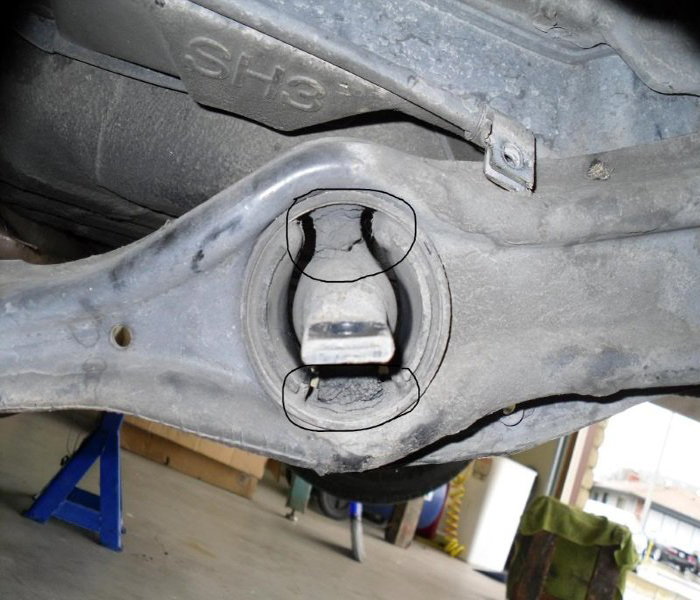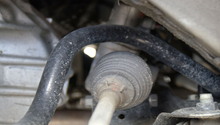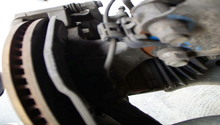Toyota Camry 2002-2006: Steering Vibration Diagnostic Guide
A vibration felt through the steering wheel can be narrowed down by taking notice of what causes the vibration and when it occurs. By compiling information on the what type of driving makes the steering wheel vibrate, you will be on your way to a quick repair.
This article applies to the Toyota Camry (2002-2006).
The steering, suspension, wheels, as well as tires can all create vibrations and unwanted movement at the steering wheel. Tires and wheels must remain in balance, otherwise only sections of the tire will contact the road while it's rotating. This creates an impact felt as a shock to the driver instead of the normal circular rotation associated with tire movement. The steering system must give the user precise steering feel and control for safe driving. This is not the case when components in the steering rack or tie rods develop looseness, creating "dead zones" in the steering wheel. Suspension components such as bushings for control arms absorb movement and keep the fit between metal components tight. When bushings deteriorate, these components are allowed to move around one another, which transfers unwanted movement throughout the vehicle.

Materials Needed
- Floor jack
- Jack stands (at least 2)
- Tire pressure gauge
- Tire tread depth gauge
- Pry bar
- Flashlight
- Gloves
- Safety glasses
This guide will be listed from easiest check to perform to the hardest. Depending on the severity of the problem, you may want to start with Step 4 first.
Step 1 – Check tire pressures
Incorrect tire pressure can have a negative effect on your steering.
Located on the A or B pillar door frame, the glove compartment, or the fuel filler door is the tire placard. The tire placard list the correct PSI levels for the front and rear tires. Make sure the tires pressure readings on your set match this sticker.

(Related Article: How to Change a Tire and Check Tire Pressure - CamryForums.com)
If the readings you got from your tires are all great, then move on with Step 2.
Step 2 – Inspect wheels/tires/suspension components
The problem could be coming from worn suspension parts.
This is best done with the vehicle as high off the ground as possible. Use the factory jacking points to raise the vehicle and support it at each corner with jack stands.
Once the vehicle is raised look over each tire for uneven wear patterns or lumps. Spin the tire and take note of any wobbling. Grab each tire at the three and nine position and wiggle it, noting any free play. Do the same with your hands at the six and twelve position. Move to the suspension components and check the shocks for fluid leakage. Look at the rubber bushings at the sway bars, control arms, subframes, and stabilizer bars for cracks/deterioration. Give these components a shake to see if any movement is present at the bushings. Move over to the steering rack and inspect the rack mounts/bushings for damage. Look where the steering shaft meets the rack and check for play in the universal joints by wiggling the shaft. The shaft can also be inspected from inside the car. Also check the condition of the engine and transmission mounts.
Uneven wear patterns on the tires can indicate faulty suspension components, a damaged tire, or a tire at the wrong air pressure. Play in the wheel while wiggling indicates damage to the wheel bearings.

Figure 2. A tire with uneven wear due to an alignment problem. 
Figure 3. A damaged control arm bushing.
(Related Article: How to Jack up Your Car - CamryForums.com
If all the components visually check out, then continue to Step 3.
Step 3 – Perform steering/suspension test
Since the components looked okay, it's time to move on to testing them.
To test the ball joints for play, place your floor jack under the tree and raise the tire to simulate a loaded condition. Turn the wheels side to side and move them up and down while noting any free play in the ball joints. You can leave the wheel jacked up or lower the vehicle back to the ground to check the steering system. Grab the shaft of the axle and wiggle it, being careful not to damage the rubber boot. There should be zero movement in the axle joint. Grab each tie rod and wiggle it back and forth. Note any free play in the rack and/or of the tie rod ends. The idea is to have the steering/suspension system loaded as close as possible to driving conditions for the most accurate check.
Any play found in ball joints or steering components indicates replacement is needed.

If the components all seem to be working properly and are not worn, then proceed to Step 4.
Step 4 – Perform road test
Time to put the rubber to the road to see what's what.
If you're still having trouble finding the faulty component, and you've deemed the vehicle road worthy, go for a test drive. During this test drive take note of what speed the vibration occurs as well as what your driving over when it occurs.
If the vibration occurs when you're turning, your focus should be on the steering system. Vibrations that change solely with speed point towards the wheels/tires. Vibrations that occur when driving over holes, for example, most likely indicate suspension problems.
If any unusual noises are present, take note of them as well. A clicking sound while turning can indicate a bad axle. Try making a sharp turn in reverse to see how the noise changes if at all. A humming sound that changes with speed is commonly found with bad wheel bearings. Clunks and rattles heard while driving over bumps point towards mounts associated with the steering rack, suspension components or even the engine/transmission mounts.
After narrowing down the affected system, make another inspection. Record your findings and take the results of your testing to a professional automotive repair facility. The technicians will be able to examine alignment angles to narrow down your fault.

Related Discussions
- Steering Wheel Vibration - CamryForums.com
- Humming Vibration Problem - CamryForums.com
- Steering Shake - CamryForums.com
- Car Feels Off Balance - CamryForums.com
- Steering Issue, Pulsation - CamryForums.com






